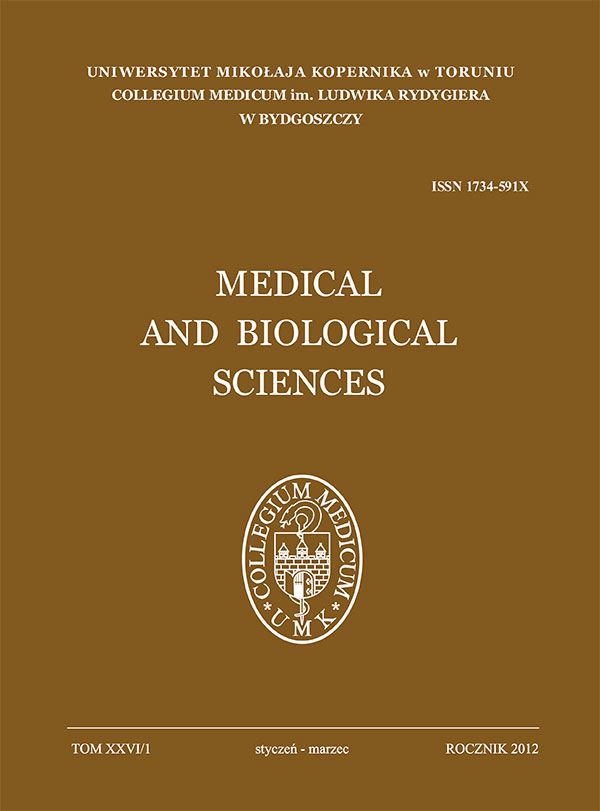Determination of ECP Concentration in Patients with Allergic Type of Food Hypersensitivity and in Patients with Dyspeptic Symptoms not Associated with Food Allergy
DOI:
https://doi.org/10.12775/4100Keywords
food allergy, ECP, eosinophilAbstract
Introduction. The results of many studies suggest that the tendency towards the prevalence of food allergies is increasing [1, 2, 3]. It is estimated that approximately 20% of population modifies their diet due to adverse reactions observed after ingestion of certain foods [2]. Still, the exact prevalence rate of food allergies in pediatric and adult populations cannot be satisfactorily estimated [4].
The aim of this study was to determine serum concentrations of eosinophil cationic protein (ECP) in patients with allergic type of food sensitivity and to compare them to data obtained from patients with dyspeptic disorders without a concomitant allergic condition.
Material and methods. This study included a group of 80 patients; among them 50 individuals with diagnosed food sensitivity based on existing standards, and 30 subjects with dyspeptic symptoms without an associated allergic condition. Venous blood was collected from each participant and ECP concentration was determined by means of fluoro-immunoenzyme assay (FIA) with UniCAP ECP test (Pharmacia Diagnostics).
Results. The arithmetic mean serum ECP concentration in patients with food allergy was found to be 24.604 ± 40.36 μg/l. In all individuals, serum ECP concentrations were within the detection limit of the applied method. The average concentration of ECP in a group of subjects without food allergy was determined to be 29.9±64.76 μg/l and did not exceed the lower or the upper detection limit of the applied method.
Conclusions. Patients with food allergy did not differ significantly from those with dyspeptic symptoms without a concomitant allergy in terms of ECP concentration (Mann-Whitney U test, p=0.754218).
References
Bartuzi Z. "Alergia pokarmowa w praktyce gastroenterologicznej- problem wciąż mało znany i niedoceniany", Alergia 2003, 1/16.
Mansueto P., Montalto G. and all. "Food allergy in gastroenterologic disease: Review of literature", World J Gastroenerol 2006 December 28.:12 (48):7744-7752.
Samoliński B., Raciborski F., Tomaszewska A. i wsp., "Częstość występowania alergii w Polsce -program ECAP", Alergoprofil 2007, Vol. 3, Nr 4, 26-28.
Wysocka M., Jędrzejczak-Czechowicz M., Kowalski M. "Nadwrażliwość na pokarmy wśród dorosłych mieszkańców Łodzi- badanie ankietowe" Alergia Astma Immunologia, 2007, 12 (4):191-199.
Cochrane S., Beyer K., Clausen M., Wjst M., Hiller R., Nicoletti C. and all "Factors influencing the incidence and prevalence of food allergy". Allergy 2009: 64: 1246-1255. http://www.ncbi.nlm.nih.gov/pubmed/19663867, http://gateway.webofknowledge.com/gateway/Gateway.cgi?GWVersion=2&SrcApp=PARTNER_APP&SrcAuth=LinksAMR&KeyUT=000268968700002&DestLinkType=FullRecord&DestApp=ALL_WOS&UsrCustomerID=b7bc2757938ac7a7a821505f8243d9f3
Kaczmarski M., Matuszewska E. "Diagnostyka alergii i nietolerancji pokarmowej u dzieci". Alergia Astma immunologia 2000, 5(2), 77-81.
Kuźmiński A., Graczyk M., Przybyszewski M., Bartuzi Z. "Alergia na pokarmy pochodzenia roślinnego - narastający problem współczesnej alergologii (część II)". Współczesna Alergologia info 2009, tom 4/nr 3 (14); 105-111.
Malinowska E., Kaczmarski M. "Alergia pokarmowa u dzieci i młodzieży". Klinika 2001, 26 kwietnia-7 maja, Nr 32-35(3027-3030).
Ariana D. Buchanan, Todd D. Green, Stacie M. Jones and All "Egg oral immunotherapy in nonanaphylactic children with egg allergy", J Allergy Clin Immunology, January 2007, Volume 119, Number 1, 199-205.
Ujwala Kaza, MD, Adina Kay Knight, MD, Sami L. Bahna, MD, DrPH "Czynniki ryzyka alergii pokarmowej". Medycyna po Dyplomie 2008, Vol. 17/Nr 3 (144), 23-28. "Risk Factors for Development of Food Allergy" Current Allergy and Asthma Reports 2007, 7:182-186.
Holgate S. T., Church M. K., Lichtenstein L. M. "Alergia" Wydawnictwo Czelej, Lublin 2003.
Kowalski M. L. "Immunologia kliniczna" Oficyna Wydawnicza MEDITON, Łódź 2000.
YQ Hsu, CYF Lo "A case of eosinophilic gastroenteritis", HKMJ 1998;4:226-228.
Kuziemski K., Jassem E. "Eozynofilie płucne" Alergia, 2008, 2: 24-27.
Matusiewicz K., Mowszed K., Iwańczak B., Matusiewicz M. "Eozynofilowe białko kationowe - znaczenie w patofizjologii i diagnostyce", Adv Clin Exp Med. 2006, 15, 4, 683-688.
Chazan R. "Pneumonologia i alergologia praktyczna - badania diagnostyczne i terapia" Bielsko - Biała, α - medica press 2001/2003.
Czarnobilska E., Olejarz P., Obtułowicz K. "Rola eozynofila w chorobach alergicznych i niealergicznych" Alergologia • Immunologia 2007, tom 4, numer 3-4, 53-57.
Boix E., Carreras E., Nikolovski Z., Cuchillo C. M., Nouges V. M. "Identification and characterization of human eosinophil cationic protein by an epitope-specific antibody" Journal of Leucocyte Biology, 2001 June, Vol. 69: 1027-1035.
Woschnagg Ch., Rubin J., Venge P. "Eosinophil Cationic Protein (ECP) is processed during sectretion1" The Journal of Immunology, 2009, 183, 3949-3954. http://gateway.webofknowledge.com/gateway/Gateway.cgi?GWVersion=2&SrcApp=PARTNER_APP&SrcAuth=LinksAMR&KeyUT=000270179700047&DestLinkType=FullRecord&DestApp=ALL_WOS&UsrCustomerID=b7bc2757938ac7a7a821505f8243d9f3
Rosenberg H. F. "Recombinant human eosinophil cationic protein ribonuclease activity is not essential for cytotoxity" The Journal of Biological Chemistry, 1995, Issue April 7, Vol. 270, No. 14, 7876-7881.
Venge P. "Monitoring of asthma inflammation by serum measurements of eosinophil cationic protein (ECP). A new clinical approach to asthma management" Respiratory Medicine (1995), 89, 1-2.
Zapalka M., Kopriva Fr., Szotkowska J. "Monitoring of serum eosinopil cationic protein (ECP) level and its clinical value in paediatric practice" Acta Univ. Palacki. Olomuc., Fac. Med. 1998, Volume 141; 21-23.
Czaja-Bulsa G., Małecka G. "Równoczesna ocean stężenia eozynofilowego białka kationowego i eozynofilii krwi obwodowej w czasie dodatnich prób prowokacji pokarmowych "Pediatria Współczesna, Gastroenterologia, Hepatologia i Żywienie Dziecka 2002, 4, 3, 225-229.
Rosińska A., Stajkowska I., Cichy W. "Rola alergenów pokarmowych w etiopatogenezie atopowego zapalenia skóry " Post Dermatol Alergol 2007; XXIV, 5: 224-232.
Nikoronow E., Godlewska R., Jagusztyn - Krynicka E. K. "Oddziaływanie Helicobacter pylori na komórki systemu odporności wrodzonej" Post. Mikrobiol. 2008, 47, 2, 137-148.
Published
How to Cite
Issue
Section
Stats
Number of views and downloads: 0
Number of citations: 0



